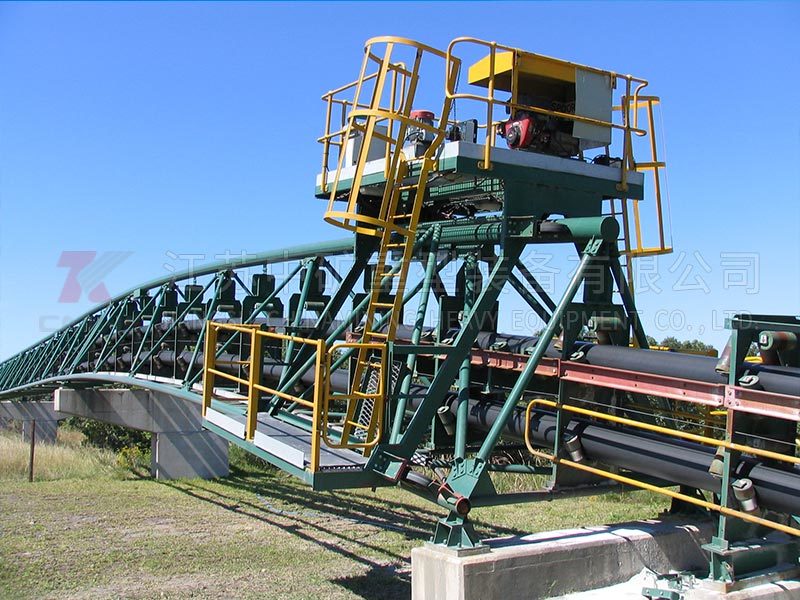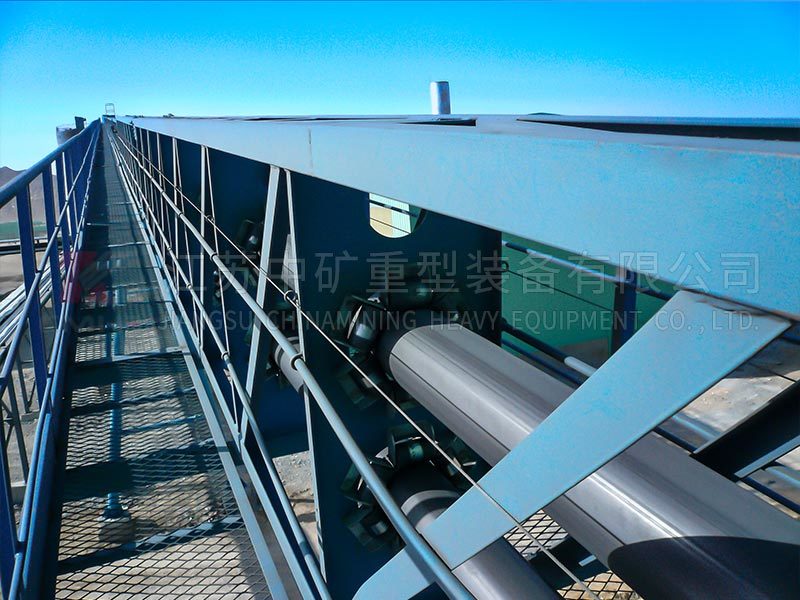
belt conveyor
Keywords:
Heavy machinery | Power station auxiliary equipment | Engineering general contracting | Mining machinery | Environmental protection equipment
Category:

Service hotline:
belt conveyor
Pipe belt conveyor is a new type of belt conveyor, which is a special type of belt conveyor developed on the basis of traditional groove belt conveyor. In the loading and unloading areas, the belt is opened in a groove shape. After loading or unloading, the belt is rolled into a circular shape by pressure rollers. After the circular tube is formed, the hexagonal arranged rollers maintain their tubular shape.
Performance characteristics
In addition to the performance and characteristics of ordinary belt conveyors, pipe belt conveyors also have more prominent features.
Wide range of conveying materials
It can transport various loose and block materials (including materials with high temperature and certain acidity and alkalinity). At present, tubular belt conveyors are widely used in industries such as steel, building materials, ceramics, papermaking, grain, salt making, and chemical engineering.

Due to the material being enclosed in a tubular belt for operation, it will not scatter or fly, nor will it be affected by external environment such as wind and rain. It can reduce the loss of materials during transportation, especially when transporting materials such as slag and ore; it can reduce the pollution of materials to the environment.
Strong adaptability of the line
Compared to other forms of belt conveyors, an important advantage of pipe belt conveyors is their small radius bending ability. For most applications, this advantage is important because there is no need to establish a transfer point when the direction of the conveyor belt needs to change sharply. The rollers are enclosed in a circular shape around the conveyor belt and can be bent in any direction. Bending can be carried out on horizontal or vertical surfaces or even both surfaces, eliminating the need for additional drums, feeding hoppers, dust collectors or dust removal equipment, foundations, or power distribution, resulting in a significant reduction in material loss. But what is important is that the maintenance issues of the transfer point are eliminated. A pipe belt conveyor can have multiple curved sections, so a single pipe belt conveyor can replace multiple universal belt conveyors and their associated transfer points, as well as the aforementioned additional equipment. It occupies small space and reduces transport stations. The single machine is long, and the conveyor line can be arranged along spatial curves, which can adapt to various complex terrains.
Large inclination conveyor
Due to the circular tube shape of the belt, the friction coefficient between the material and the belt is increased, and the contact area between the material and the conveyor belt is also increased. The inclination angle of the conveyor is increased by 50%, so the maximum inclination angle of the line can reach 30°. For materials with poor fluidity, the inclination angle can also be increased. This feature is very important for conveying materials to high places, as it can reduce the conveying length, save space and location, and reduce equipment costs. The larger the tilt angle, the shorter the conveyor length, and it may become a more economical or feasible solution under space and performance limitations.
The conveyor belt forms a circular tube shape during the return journey.
The return belt of the pipe belt conveyor is also in the shape of a circular tube. The conveyor belt is rolled up, and the overlapping part is located at the bottom of the circular tube. This not only allows the conveyor belt to pass through the same bending route as the bearing side, but also makes the dirty side of the conveyor belt wrapped, reducing the possibility of material dripping or scattering.
Transport materials in both directions simultaneously
Due to the circular shape of the belt for both the loaded (upper) and unloaded (lower) branches, the unloaded branch can be used to transport materials in the opposite direction. But special feeding devices need to be set up.
Same conveying capacity as that of larger universal belt conveyors
The conveying capacity of a pipe belt conveyor is usually the same as that of a universal belt conveyor with a bandwidth of 2.5 to 3 times its pipe diameter. For example, a pipe belt conveyor with a pipe diameter of 300mm (12in) has the same conveying capacity as a universal belt conveyor with a bandwidth of 800mm (30in), a roller groove angle of 20º, and a discharge angle of 20º. But the support of this pipe belt conveyor is only 635mm (25in) wide, and the support of the universal belt conveyor needs to be 1050mm (41in) wide. In situations where the installation space of the conveyor is limited, such as in tunnels, using pipe belt conveyors can adopt the design of smaller tunnel cross-sections.
标准部件
Standard componentsPipe belt conveyors and universal belt conveyors can use the same standard components. Due to the flat shape of the conveyor belt at the head, tail, and tension drum of the pipe belt conveyor, and the belt speed is consistent, standard universal belt conveyor drums, bearings, and driving devices can be used. The standard components used are interchangeable, so using a pipe belt conveyor is a suitable choice.
High reliabilit
Simple structure, light-weight operating components, easy maintenance, no deviation of the belt, and reliable operation
Low conveying noise
Main parameters of tubular belt conveyor
Table 1 Bandwidth, cross-sectional area, and allowable block size corresponding to different pipe diameters
|
mm Pipe diameter |
100 |
150 |
200 |
250 |
300 |
350 |
400 |
500 |
600 |
700 |
850 |
|
Bandwidth |
|
600 |
780 |
1000 |
1150 |
1300 |
1600 |
1900 |
2250 |
2550 |
3100 |
|
100%(mm2) Cross Section |
|
0.0178 |
0.0313 |
0.0529 |
0.0636 |
0.8773 |
0.144 |
0.207 |
0.288 |
0.379 |
0.544 |
|
75%(mm2) Cross Section |
|
0.013 |
0.023 |
0.040 |
0.048 |
0.066 |
0.108 |
0.155 |
0.216 |
0.284 |
0.408 |

|
Max block size |
30 |
30-50 |
50-70 |
70-90 |
90-100 |
100-120 |
120-150 |
150-200 |
200-250 |
250-300 |
300-400 |
|
Corresponding width of ordinary belt conveyor |
430 |
600 |
750 |
1000 |
1100 |
1300 |
1600 |
1900 |
2200 |
2550 |
3100 |
Table 2: Matching relationship between pipe diameter d, belt speed v, and conveying capacity IV
|
|
100 |
150 |
200 |
250 |
300 |
350 |
400 |
500 |
600 |
700 |
850 |
|
0.8 |
17 |
37 |
66 |
118 |
138 |
|
|
|
|
|
|
|
1.0 |
21 |
47 |
83 |
148 |
173 |
238 |
|
|
|
|
|
|
1.25 |
26 |
59 |
104 |
185 |
216 |
297 |
482 |
688 |
|
|
|
|
1.6 |
34 |
75 |
132 |
232 |
276 |
380 |
616 |
881 |
1238 |
1618 |
2327 |
|
2.0 |
42 |
94 |
166 |
296 |
346 |
472 |
770 |
1100 |
1548 |
2022 |
2909 |
|
2.5 |
|
119 |
208 |
370 |
432 |
594 |
964 |
1376 |
1935 |
2528 |
3636 |
|
3.15 |
|
|
|
457 |
543 |
748 |
1213 |
1734 |
2438 |
3185 |
4581 |
|
4.0 |
|
|
|
|
|
|
1540 |
2200 |
3096 |
4044 |
5818 |
|
5.0 |
|
|
|
|
|
|
|
|
3870 |
5056 |
7272 |
Note: The volumetric conveying capacity is based on horizontal conveying, and the filling rate is based on ψ=0.7
Layout dimensions of tubular belt conveyors
Table 3: Basic radius of curvature
|
Name |
Bending radius |
||
|
|
Nylon core tape or polyester tape |
Steel cord belt |
|
|
Horizontal bending |
d管x300 |
d管x700 |
|
|
S-shaped bending |
d管x400 |
d管x800 |
|
|
Concave arc bending |
d管x300 |
d管x700 |
|
|
Convex arc bending |
d管x400 |
d管x800 |
|
|
Space bending |
Horizontal+concave arc |
d管x400 |
d管x800 |
|
Horizontal+convex arc |
d管x500 |
d管x900 |
|
More Products
Product Consultation
Website

Service hotline
Business Department:
Zhou Baohua 86-13906278080
Technical support:
Ding Baoqin 86-13906276368
Fax: 86-513-88400998
E_ mail: jszk@vip.163.com
Address: No. 29 Xingdian West Road, Baidian Town, Hai'an City, Jiangsu Province







